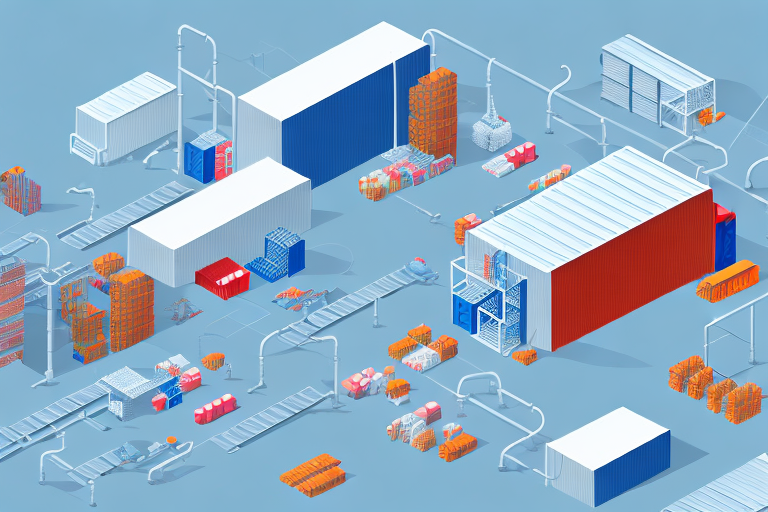Optimizing Production and Logistics for Maximum Efficiency
Efficiency is a critical determinant of success for businesses involved in production and logistics. The ability to manufacture goods swiftly and cost-effectively, coupled with the proficient management of transportation and distribution, can significantly influence profitability and competitive advantage. This article delves into the significance of optimizing production and logistics, explores the benefits of streamlined operations, and presents strategies to enhance efficiency.
The Importance and Benefits of Efficient Production and Logistics
Optimizing production and logistics processes can profoundly impact a company's financial health and market position. Streamlined operations lead to cost savings in production, transportation, and distribution, thereby boosting profits and providing a competitive edge.
- Cost Savings: Reducing waste and enhancing efficiency can lower operational costs across the board.
- Improved Customer Satisfaction: Faster delivery times and reliable service enhance customer experiences.
- Increased Productivity: Efficient processes enable higher output with the same or fewer resources.
- Competitive Advantage: Superior efficiency can differentiate a business from its competitors.
Conversely, inefficiencies can lead to wasted resources, delayed deliveries, and damaged products, which erode customer trust and harm the company's reputation.
Key Elements of Efficient Production and Logistics
Several factors contribute to the efficiency of production and logistics operations:
- Effective Planning and Forecasting: Accurate demand forecasting ensures optimal resource allocation and aligns production with market needs.
- Streamlined Production Processes: Standardizing work methods and maintaining equipment reduce variability and prevent downtime.
- Robust Supply Chain Management: Coordinating with reliable suppliers and transportation providers ensures timely and quality deliveries.
- Inventory Management: Balancing inventory levels to meet demand without overstocking minimizes holding costs and reduces the risk of stockouts.
- Technology and Data Analytics: Leveraging advanced technologies provides real-time insights, enabling continuous process improvements.
Strategies for Streamlining Operations
Implementing effective strategies can significantly enhance production and logistics efficiency:
- Lean Manufacturing: Adopting lean principles helps eliminate waste and optimize workflows.
- Automation and Robotics: Introducing automation increases productivity and reduces labor costs.
- Advanced Technology: Investing in ERP systems and real-time tracking tools enhances operational visibility and decision-making.
- Enhanced Communication: Improving collaboration between departments and stakeholders ensures seamless operations.
- Flexible Strategies: Developing adaptable production and distribution plans allows businesses to respond swiftly to market changes.
The Role of Technology and Data Analytics
Technology and data analytics are pivotal in optimizing production and logistics:
- Enterprise Resource Planning (ERP) Systems: Integrating all facets of production and logistics for streamlined operations.
- Real-Time Tracking: Utilizing RFID tags and sensors for monitoring goods and materials, ensuring transparency and reducing losses.
- Data Analytics: Employing descriptive, predictive, and prescriptive analytics to identify trends, forecast demand, and make informed decisions.
- Automation: Implementing robotic systems to handle repetitive tasks, thereby increasing efficiency and reducing errors.
According to a McKinsey report, companies that effectively leverage technology in their production and logistics operations can achieve up to a 20% increase in efficiency.
Best Practices and Case Studies in Production and Logistics Optimization
Adopting best practices and learning from successful case studies can guide businesses in optimizing their operations:
- Inventory Management: Implementing just-in-time inventory systems to reduce holding costs and increase responsiveness.
- Supply Chain Collaboration: Building strong relationships with suppliers and partners to enhance reliability and efficiency.
- Continuous Improvement: Fostering a culture that encourages ongoing process evaluation and optimization.
For example, Toyota has long been recognized for its implementation of lean manufacturing principles, resulting in improved quality and reduced waste. Similarly, Amazon utilizes advanced data analytics and automation to streamline its logistics operations, ensuring rapid delivery and high customer satisfaction.
Overcoming Challenges and Future Trends
While optimizing production and logistics presents numerous benefits, it also comes with challenges:
- Resistance to Change: Employees and stakeholders may be hesitant to adopt new processes and technologies.
- Resource Limitations: Budget constraints and limited manpower can hinder optimization efforts.
- Supply Chain Complexity: Managing a diverse and global supply chain requires sophisticated coordination and communication.
- Technology Integration: Integrating new technologies with existing systems can be complex and time-consuming.
Despite these challenges, businesses can successfully navigate the optimization process by fostering a culture of continuous improvement, investing in training and development, and leveraging technology to enhance operational capabilities.
Looking ahead, several trends are shaping the future of production and logistics:
- Increased Automation: Robotics and AI will continue to transform manufacturing and logistics processes.
- Sustainability: Emphasis on environmentally-friendly practices will drive changes in production and logistics strategies.
- Enhanced Data Utilization: Advanced analytics and real-time data will enable more precise forecasting and decision-making.
- E-commerce Growth: The expanding e-commerce sector will necessitate more efficient and scalable logistics operations.
Staying abreast of these trends and proactively adapting strategies will be essential for businesses aiming to maintain and enhance their production and logistics efficiency.
Measuring Success with Key Performance Indicators (KPIs)
To ensure that optimization efforts are effective, it is crucial to monitor progress through key performance indicators (KPIs). Common KPIs for production and logistics include:
- Overall Equipment Effectiveness (OEE): Measures the efficiency and effectiveness of equipment in the production process.
- Cost of Goods Sold (COGS): Calculates the direct costs attributable to the production of goods sold.
- On-Time Delivery Rate: Assesses the percentage of orders delivered on or before the promised date.
- Inventory Turnover Ratio: Inventory turnover ratio indicates how often inventory is sold and replaced over a specific period.
- Lead Time: The total time taken from the initiation of a process to its completion.
By regularly tracking these KPIs, businesses can identify areas for improvement, make informed decisions, and ensure that their production and logistics operations contribute positively to overall business performance.




















